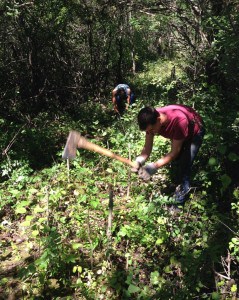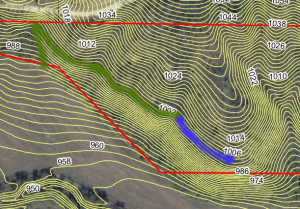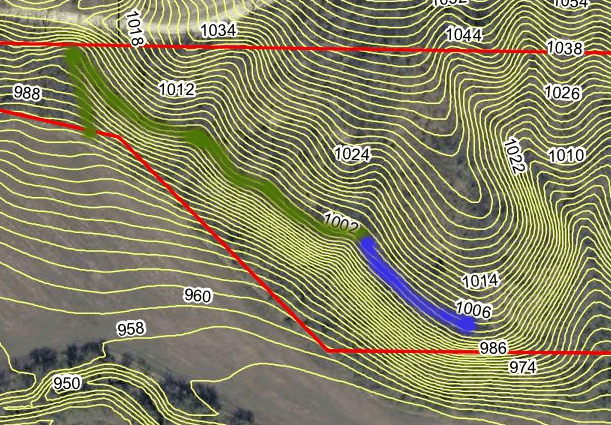Most are doing well, a few have failed. Also in the mix are chives and daffodils, but exact locations not noted. At the moment it looks like another 19 trees and 13 shrubs to complete the berm next spring . . .
Here’s the current listing, east to west. Shrubs in italics.
[Planted 2015]
Rhubarb
Apple: Roxbury Russet
Elderberry
Apple: Cox’s Pippin
Elderberry
Cherry: Gisella – Black Gold
Elderberry
Cherry: Gisella – Black Gold
Elderberry
Pear: Aurora
Elderberry
Pear: Potomac
Elderberry
Pear: Harrow Sweet
Elderberry
[Planted 2014]
Apple: Snow Sweet
Currant
Apple: Honeycrisp
Currant
Apple: Haralson(?)
Elderberry
Plum: American
Currant
Plum: Mount Royal
Elderberry
Plum: Pipestone
Serviceberry (bush)
Currant
[Needed: Tree: Serviceberry]
Currant
Serviceberry (bush)
Cherry: Evans Bali
Currant
Cherry: Northstar
[needed: shrub]
Cherry: Mesabi
Elderberry
[Planted 2015]
Apple: Enterprise
Elderberry
[failed: Apple: Cox’s Pippin]
Elderberry
Apple: Roxbury Russet
[shrub]
[failed: Pear: Aurora]
[shrub]
Pear: Potomac
Elderberry
Pear: Harrow Sweet
Elderberry
Apple: Enterprise
Elderberry
Apple: Goldrush
[shrub]
Apple: Pristine
Elderberry
Apple: Goldrush
[shrub]
Last Stretch:
[tree]
[shrub]
[tree]
[shrub]
[tree]
[shrub]
[tree]
Currant
[tree]
Elderberry
[tree]
[shrub]
[tree]
Elderberry
[tree]
[shrub]
[tree]
[shrub]
[tree]
Elderberry
[tree]
Raspberry
[tree]
Raspberry
[tree]
Raspberry
[tree]
[shrub]
[tree]
[shrub]
[tree]
[shrub]
[tree]
I keep hearing that “Access to Land” is a key challenge for folks who want to do well by the soil. That the high cost of farmland and the consolidation of farms into mega-operations over the last few decades make it really difficult for younger farmers especially, to get onto the land and employ practices that care for the land, build resilience and sequester carbon.
So we bought a farm.
We bought it, in part, to be a sort of sandbox to work on the problem of land access for diversified, small (family) scale, sustainable agriculture. And the learning continues.
For several years now when not engaged in keyline projects or just getting the infrastructure repaired, I’ve been exploring farm finance options. In the course of that I came across the word “musharakah” which denotes a practice in Islamic finance used for large purchases – in fact, in the USA more than 2 billion dollars worth of homes have been financed this way. What I have learned so far intrigues me and may offer a pathway to land access with key differences from conventional financing.
What is musharakah? As I understand it, musharakah is a specialized form of partnership in which someone with capital partners with someone with energy in order to establish a joint enterprise. There are several variations on this in Islamic finance, but the one that intrigues me is often termed Declining Musharakah. The key feature of this form is that the intent of the partnership is the long-term transfer of ownership from the partner with capital (who I’ll call the funder from here on) to the partner with expertise (the farmer).
How it works: A musharakah is a partnership established between two (or more?) individuals who agree to enter into business together with joint ownership. Importantly, in a declining musharakah partnership the ownership is unequal and changes over time. Initially the funder puts up most of the capital and owns most of the business. For example if the partnership buys a farm for $100,000 and the funder provides $95,000 and the farmer provides $5,000 – then the funder owns 95% of the business and the farmer 5%. The purpose of a declining musharakah is for those percentages to change so that the farmer eventually owns 100%. To accomplish this, the partners agree that the asset (farm) has a rent value, for example $1000 per year. This rent is to be paid by the user of the asset (the farmer) to the partnership which then distributes it according to the ownership percentage: initially $950 to the funder and $50 to the farmer. Should the farmer earn more than the rent, that is hers to keep – or to use to purchase from the funder an additional percentage of the farm. The key concept here is that over time the farmer is expected to purchase additional ownership from the funder whose ownership interest in the farm declines over time thus this is a ‘declining musharakah’.
For me, one of the key features of this concept is the understanding that the value of the asset may change over time and that ownership is always a percentage of the value at any point in time. If there has been a substantial change in value for reasons external or internal then the price of any percentage changes accordingly (details in a later post). This means that both partners have a powerful concern for the value of the farm which makes this approach radically different from conventional finance in that the goals of the farmer and investor are aligned rather than in opposition. By and large, conventional banks want their interest and how you get the money to pay that isn’t their concern. You can exhaust the soil, pour it full of chemicals, do whatever – they don’t care as long as they get paid. But in musharakah both parties have a stake in the value and stewardship of the farm and incentive to care for and, if possible, improve it.
This notion of value changing over time is, to me, important in another way. It appears to me (and to every banker I’ve asked) that the problems that led to 2008 have not really been fixed, i.e. there continues to be enormous systemic risk in the global financial system. Some other event – probably different but certainly negative – is in our collective future. What it will look like and when it will happen I can’t predict, but thinking in Transition terms, I want my nest egg to be resilient in order to survive whatever the next event turns out to be. If I share ownership in my farm with a farmer and the real estate market crashes – or skyrockets – I don’t really care. I have an ownership interest in a productive asset that could be valued in dollars, euros, cowrie shells or bushels of wheat. The intrinsic value of the asset remains regardless of the market, interest rates, currency devaluations, inflation, deflation or whatever.
So that’s a quick overview of some of what I’ve learnt about musharakah. I am unaware of this being used for agricultural finance in the USA, but it seems like an idea with an existing body of practice (the 2 billion dollars worth of homes in the USA!) and enormous potential.
All questions and comments welcome!
Thanks to awesome efforts by Lolo and his friend Joey, the first phase of the Keyline path project is complete (they did the section in blue show in this post). Doris (the UTV) can now run the entire length of the path providing access for managing the woods and upper prairie area, mushroom hunting and perhaps critter management in the future. Thanks, guys!
Lovely progress on the keyline path. This provides access to the wooded hillside on the north part of the farm. The green line shows the portion now complete and the blue what I hope to finish this summer. We shall see!
Just for fun, here’s a video shot from Doris driving from where the blue and green lines meet (cherry tree corner) out onto the field.





